 Teams of aerospace researchers across the USA are signing up to compete for $500,000 in prize money by demonstrating the ability to fly unmanned aircraft through an airspace obstacle course.
Teams of aerospace researchers across the USA are signing up to compete for $500,000 in prize money by demonstrating the ability to fly unmanned aircraft through an airspace obstacle course.
NASA 2014 Unmanned Aircraft Systems (UAS) Airspace Operations Challenge will be hosted by the Ohio/Indiana UAS Center and Test Complex and will take place at Camp Atterbury Joint Manoeuvre Training Center near Edinburgh, Indiana. Through the challenge competitors will demonstrate their ability to safely operate in airspace shared by cooperative air traffic. The competition is focused on developing and demonstrating key technologies needed for autonomous flight of unmanned aircraft systems, particularly their ability to sense and avoid other air traffic.
Advances in autonomous systems technologies will one day enable robotic aircraft to operate safely in the same airspace as piloted aircraft. Before unpiloted or remotely piloted aircraft can safely operate in the same airspace as other, piloted aircraft, robotic aircraft and their operators will need to demonstrate a high level of operational robustness and the ability to “sense and avoid” other air traffic (SAA). The Unmanned Aircraft Systems Airspace Operations Challenge (UAS AOC) is focused on developing some of the key technologies that will make UAS integration into the National Airspace System possible.
SAA, is key to successfully meeting Phase 1 competition objectives. Competitors will also demonstrate basic airmanship and air vehicle capabilities, through a series of ground and flight events intended to measure key performance capabilities, requiring a high level of robustness.
Registration began two months ago for the NASA 2014 Unmanned Aircraft Systems (UAS) Airspace Operations Challenge, coordinated by Development Projects Inc. (DPI) of Dayton, Ohio. Since then, numerous teams from industry and academia have signed up to demonstrate their capabilities and to compete in the first phase scheduled for April 2014. Registrations for the first phase will run through March 31, 2014. Other partners, including the Dayton Development Coalition and the National Center for Complex Operations (NCCO), are working together with NASA to showcase innovations supporting the successful integration of UAS into the National Airspace System (NAS).

This Challenge will be conducted in two parts: Phase 1 of the Challenge is scheduled to be held in Spring, 2014 and Phase 2 of the Challenge will be held approximately one year after Phase 1 has been successfully completed. The winner of the first phase will grab $500,000 in prize money, while the second phase is expected to award up to $1 million in additional prize money. Unlike contracts or grants, prizes are awarded only after solutions are successfully demonstrated.
Phase 1 of the Challenge focuses on important aspects of safe airspace operations, robustness to system failures, and seeks to encourage competitors to get an early start on developing some of the skills critical to Phase 2.
Specific skills that Phase 1 competitors will need to demonstrate include safe airspace operations and system robustness, including separation assurance using ADS-B, planning and maintaining four-dimensional trajectories, ground control operations. Demonstrating system robustness and failure recovery, competitors will be required to demonstrate managing lost links, loss of GPS or unreliable GPS readings. In preparation for Phase 2, competitors will also deal with methods to handle uncooperative air traffic detection.
While there are other technical challenges that must be solved to enable the integration of UAS in the NAS, competitor that successfully demonstrates the skills required in Phase 1 will be able to field a robust UAS that is significantly closer to the goals of UAS-NAS integration embodied in the NextGen Airspace Concept, NASA commented in its invitation.
NASA’s Centennial Challenges seek unconventional solutions to problems of interest to NASA and the nation. Competitors have included private companies, student groups and independent inventors working outside the traditional aerospace industry.

















